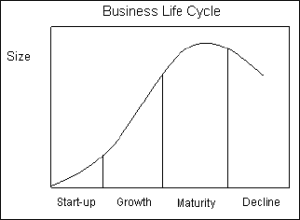Developing a Small Business Framework various researchers over the years have developed models for examining businesses each uses business size as one dimension and company maturity or the stage of growth as a second dimension.
During the growth of a small business, a company will go through the stages of the business life cycle and encounter different challenges that require different financing sources.
For example, the business will require a different strategy when it comes to market penetration, business development, and retaining market share. As the business matures, operations and priorities will change therefore requiring business financing to also change as well.
Below are the five stages of business growth every company goes through:

If you decide your business idea is worth developing, the next step is to put together a business plan.
- Start-up stage.
- Growth stage
- Expansion stage.
- Maturity stage.
Read Also: Top 10 Personal Finance Rules to Follow
1. Development / Seed Stage
The development of seed stage is the beginning of the business lifecycle. This is when your brilliant idea is merely just a thought and will require a round of testing in its initial stage.
In testing your business idea, you may conduct research regarding the industry, and gather feedback from your friends, family, colleagues, or other industry specialists.
This is when you are determining whether the business idea that you had is worth pursuing and if so it will be the birth of your new business.
Challenges
- Business Idea Profitability
- Market Acceptance
- Establishing Business Structure
- Accounting Management
2. Startup Stage
You’ve decided that your business idea is worth pursuing and have now made your business entity legal. In this stage, you’ve finished developing the products or services that your business has to offer and will begin marketing and selling.
During this stage, you will be tweaking your products or services according to the initial feedback from your first paying customers and market demand.
Read Also: Meaning and Process of Marketing Communications
You will need to learn and adjust your business model to ensure profitability and that it meets your customer’s expectations. By adjusting your business model, you’ll be able to set your business on the right track.
Challenges
- Managing Cash Reserves
- Managing Sales Expectations
- Accounting Management
- Establishing Customer Base
- Establishing Market Presence
3. Growth/Survival Stage
Your business has endured through the initial stages of the business lifecycle and is currently in its growth or survival stage. The business is consistently generating revenue and adding new customers.
This recurring revenue will help pay for your operating expenses and open up new business opportunities. Currently, your business could be operating at a net loss or maintaining a healthy profit, but there could be some competition.
This is also when you need to fine-tune your business model and implement proven methodologies, sales model, marketing model, and operations model before expanding your venture for the mass market.
Challenges
- Dealing with Increasing Revenue
- Dealing with Increasing Customers
- Accounting Management
- Effective Management
- Market Competition
Read Also: Formal and Informal Sources of Finance in Business
4. Expansion / Rapid Growth Stage
Your business has been a thriving company and established its presence in the industry. You have now reached the stage in which your business will expand and spread its roots into new markets and distribution channels.
To start capitalizing on the success of your business, you will need to capture a larger market share and find new revenue. Therefore your business will experience rapid growth in revenue and cash flow.
The rapid growth stage takes advantage of the proven sales model, marketing model, and operations model set forth from your growth/survival stage.
Challenges
- Increasing Market Competition
- Accounting Management
- Moving into New Markets
- Adding New Products/Services
- Expanding Existing Business
5. Maturity Stage
After a successful expansion, your business is on top of its industry and has matured. At the final stage of the business lifecycle, your business has a dominating presence in its market.
Read Also: Business Growth and it’s Importance
Your business could still be growing but not at the substantial rate you’ve previously experienced. Your current option is to decide to take a step back toward the expansion stage or to think of a possible exit strategy.
Challenges
- Increasing Market Competition
- Accounting Management
- Moving into New Markets
- Adding New Products/Services
- Expanding Existing Business
- Exit Strategy
Every stage of the business lifecycle brings new or pre-existing challenges. Solutions that may have worked for one stage may not work in another stage, which is why you should always adjust your business plan and operations accordingly.
At each stage, your business will rely on a financial source to help overcome the challenges your business faces.
This is especially important to have accounting management software in place so that you will have an accurate reflection of your current business finances.
Having accounting software in place will help you understand where your business is on the current business lifecycle and the details will allow you to foresee upcoming challenges and make better business decisions.
Read Also: E-Business Opportunities for Expansion
